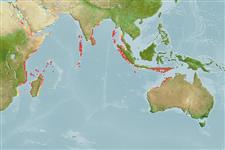>
Blenniiformes (Blennies) >
Blenniidae (Combtooth blennies) > Salariinae
Etymology: Entomacrodus: Greek, ento = inside + Greek, makros = big + Greek, odous = teeth (Ref. 45335).
More on author: Valenciennes.
Environment: milieu / climate zone / depth range / distribution range
Ecologia
marino demersale; distribuzione batimetrica 0 - 2 m (Ref. 90102). Tropical
Western Indian Ocean: Seychelles (Ref. 26282) and Maldives. Eastern Indian Ocean: Christmas Island (Ref. 30874).
Size / Peso / Age
Maturity: Lm ? range ? - ? cm
Max length : 18.0 cm TL maschio/sesso non determinato; (Ref. 30874)
Short description
Chiavi di identificazione | Morfologia | Morfometria
Spine dorsali (totale) : 13; Raggi dorsali molli (totale) : 15 - 17; Spine anali: 2; Raggi anali molli: 16 - 18. Overall greenish, large white blotches superimposed on intricate maze-like pattern, and yellowish margins on median fins. Dorsal rays rarely 15, fin deeply notched; anal rays rarely 16; pectoral rays usually 14; pelvic spine not visible externally; last lateral-line tube below 8th to 13th dorsal spines; nape typically with 1 cirrus on each side; supraorbital tentacle with 2-38 cirri (number proportional with growth); anterior nostril cirri present posteriorly; upper lip margin entirely, but weakly and irregularly crenulate; body depth at anal-fin origin about 4.1-4.5 in SL (Ref. 90102).
Facultative air-breathing (Ref. 126274); Adults are found in the intertidal area, actively shuttling back and forth between rock pools and air (Ref. 31184). They breathes air when out of water (Ref. 31184). Oviparous. Eggs are demersal and adhesive (Ref. 205), and are attached to the substrate via a filamentous, adhesive pad or pedestal (Ref. 94114). Larvae are planktonic, often found in shallow, coastal waters (Ref. 94114).
Life cycle and mating behavior
Maturities | Riproduzione | Spawnings | Egg(s) | Fecundities | Larve
Oviparous, distinct pairing (Ref. 205).
Randall, J.E. and C. Anderson, 1993. Annotated checklist of the epipelagic and shore fishes of the Maldives Islands. Ichthyol. Bull. of the J.L.B. Smith Inst. of Ichthyol. (59):1-47. (Ref. 11303)
IUCN Red List Status (Ref. 130435)
Threat to humans
Harmless
Human uses
Strumenti
Special reports
Download XML
Fonti Internet
Estimates based on models
Preferred temperature (Ref.
123201): 26.7 - 29.3, mean 28.3 °C (based on 721 cells).
Phylogenetic diversity index (Ref.
82804): PD
50 = 0.5000 [Uniqueness, from 0.5 = low to 2.0 = high].
Bayesian length-weight: a=0.00741 (0.00335 - 0.01640), b=3.02 (2.83 - 3.21), in cm total length, based on LWR estimates for this (Sub)family-body shape (Ref.
93245).
Trophic level (Ref.
69278): 2.0 ±0.00 se; based on food items.
Resilienza (Ref.
120179): Medio, tempo minimo di raddoppiamento della popolazione 1.4 - 4.4 anni (Preliminary K or Fecundity.).
Fishing Vulnerability (Ref.
59153): Low vulnerability (10 of 100).
